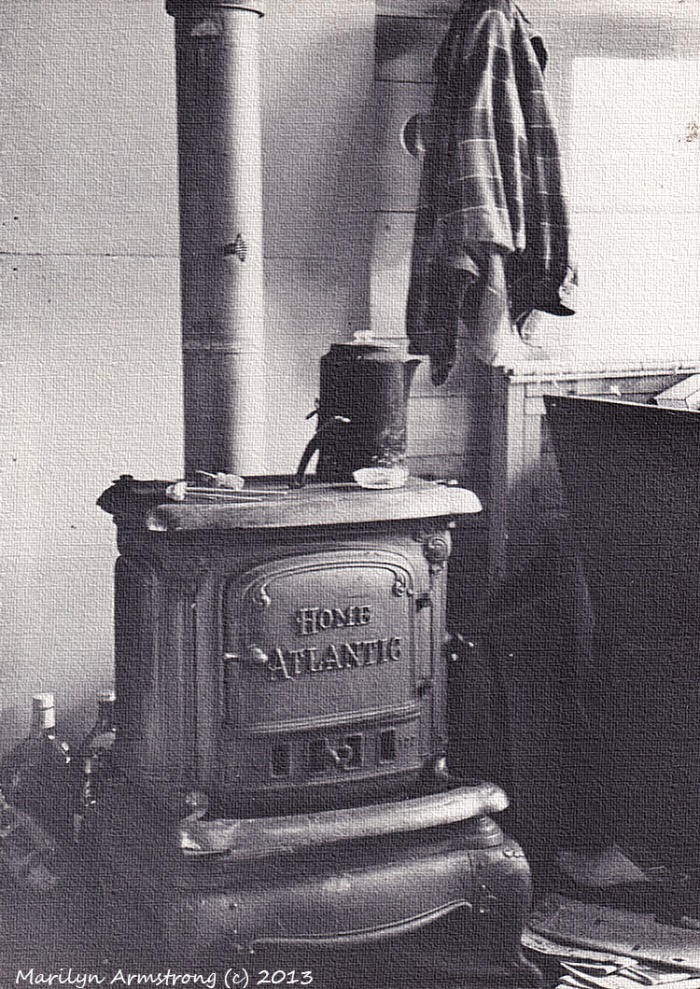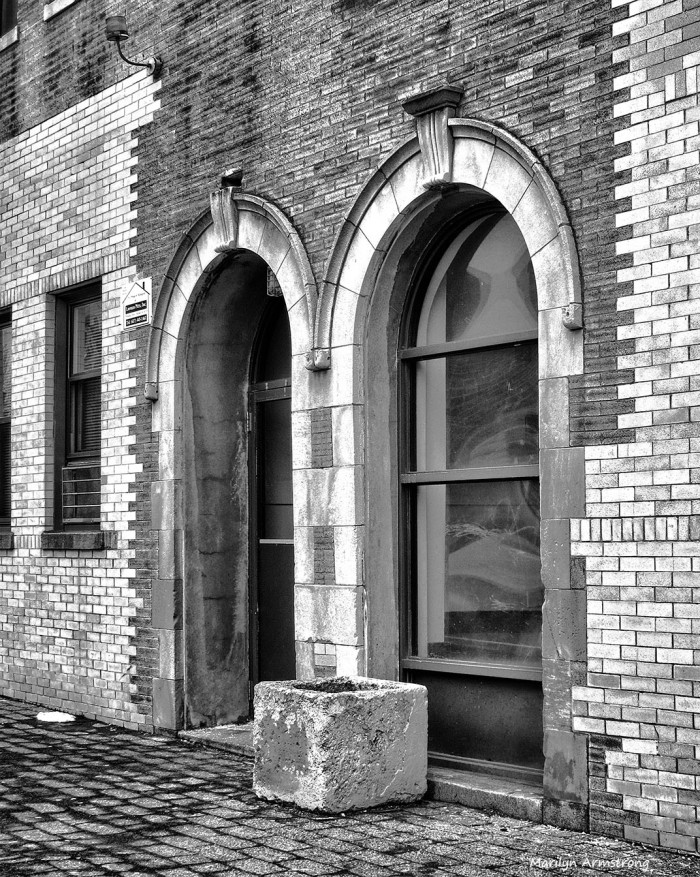I got tagged by Cordelia’s Mom, Still. Because I’ve never played — apparently one of very few people never to have participated in this open-ended, popular challenge — I thought I’d pop my oar in the water. Why not, right?
It turns out that no one is entirely sure where this began, but everyone seems to be having fun with it. It’s got only two rules:
1. On 5 consecutive days, create a post using one of your photos in B&W. It doesn’t have to be new or any particular subject. Just black and white.
2. Each day invite another blog friend to join in the fun. The hard part is going to be finding people who haven’t done it already and would like to play.
So, without further ado, I’m going to invite Willow’s Corner because she was the first friend to show up while I was writing this post.

Pleasant River Lake, Maine, August 1974. Taken in black and white, printed on textured paper. Scanned. A bit faded with age.
About black and white photographY
I learned to shoot in black and white. Film. Why black and white? Because I could process it for free and labs were expensive. And not nearly as good as having a friend who ran the university’s photo lab. I did my own printing, but he processed the film for free. I then got proof sheets — you’ve probably never seen a proof sheet — from which I’d choose the negatives to work on.
In the course of events, I learned about films and film speeds. I learned about depth of field, f-stops, shutter speed. Printing, dodging, burning — manual post processing. There are things you can do with paper, shadows, and exposures you can’t duplicate with software.
Paper texture from software is a visual effect. Real paper texture is something you can feel. I know, it sounds so … primitive.
However. There are so many things you can do with software you couldn’t imagine doing before digital photography. My feet and back are happier working in a comfortable chair on my laptop rather than standing for hours in the darkroom.
Some things you only learn in a lab
Learning on film and doing my own printing taught me stuff new photographers don’t learn. Many, maybe most photographers have never used a camera without auto-focus, much less used a hand-held meter to take a light reading.
It’s similar to the difference between learning to drive on a manual transmission rather than an automatic. Learning on a manual transmission car makes you a better driver, forever. Even if eventually you stop driving a manual. Because you know what a gear is, what a change-point is. For that matter, what a transmission does. You are always more aware of what your car is doing and what you are doing to your car.
Photographers who have never had to conform to whatever film is in the camera, who have never used a light meter, or set aperture and shutter speed to meet lighting conditions are less in control of the outcome of their pictures. It’s not my opinion. It’s true.
Real black and white photography — not converting a color picture via software in post-processing, but actually shooting in black and white — teaches composition. Color is beautiful, but it lets you be lazy. You can substitute color for design.
Color is seductive and sexy. Black-and-white is a strict teacher who makes you work harder to get a good grade, but from whom that grade is an honor.
I don’t shoot in monochrome as often as I should. I’m as lazy as the next guy.
Ah, but when the magic works …
Categories: #Photography, Challenges





 GOOD OLD DAYS
GOOD OLD DAYS  ON A DARK AND CLOUDY DAY
ON A DARK AND CLOUDY DAY  TALKING ABOUT OUR BLOGS IS ANOTHER WAY TO TALK ABOUT OURSELVES
TALKING ABOUT OUR BLOGS IS ANOTHER WAY TO TALK ABOUT OURSELVES  CRITTERS
CRITTERS
My brother was an award winning photog. We had a darkroom in the basement in Detroit and I used to help him develop his pics. B/W is my favorite. Too bad I’m not as good a photographer as he is (or you!) Lovely pics.
LikeLike
Thanks. I’m not as good technically as a lot of other photographers. I came late to Photoshop, and my equipment is good, not great. If I have an edge, it’s that I have a pretty good eye and I love photography. It has never been a business for me, just a labor of love.
LikeLiked by 1 person
Agree with you there, def a labor of love!
LikeLike
I just love that first image and like you I loved working in the dark room and experimenting with different papers. But then again I don’t miss the chemicals and the darkness of the room. It is fun with software. A lot, lot cheaper.
LikeLike
A LOT cheaper. And a lot more comfortable. Sitting here, in my recliner with the laptop. Probably you couldn’t pay me to go back into the smelly old darkroom. But the pictures were nice.
LikeLiked by 1 person
I think there was an edginess to them when you worked in the darkroom. But like you said, much more comfortable and safer.
LikeLike
I agree. As I said, it’s more sentimentality than actual interest in ever going into another darkroom.
LikeLike
You want me to follow that??? Le sigh. I won’t be as verbose, but I’m sure I can scrounge up a picture that won’t look awful. ^_^
LikeLike
I’ve been taking pictures since my son, now 46, was a baby. You learn by doing it, so a little prod never hurts. ALL of us were beginners, once. Just for we oldies, it may seem we’ve always known because we can’t remember back to when it began 🙂
LikeLike
I’ve been snapping snapshots since those old what was it? 110 cameras? Man I used to love those things. And I’ve been taking snapshots ever since. I just didn’t have the ambition to learn more.
My sister did. She took photography in school. She just didn’t go anywhere with it, and forgot more than I ever learned. ^_^
LikeLike
I started just snapping pictures of the kid … but I was good at it. I got a lot of compliments and encouragement, so I kept at it. It was never my profession, just a hobby.
LikeLiked by 1 person
Lots of great information in this post, not just that, I am a good driver 🙂
LikeLike
I learned to drive on a manual. Garry can’t drive a standard.It became inconvenient. Living in a city, then in an area with a lot of traffic isn’t conducive to a manual tranny, either. Now we have automatics and I don’t drive. I was good while I was good. Now I’m a passenger and navigator.
LikeLiked by 1 person
I got never used to an automatic transmission. I hit the brake too hard with the wrong foot. So I drive a standard and I am loving it.
LikeLike
I started to lose strength and sensation in my right leg about 8 years ago and started to have clutch control issues. That’s when I packed it in. But I LOVED driving a clutch car. I could pretend I was a race car driver 🙂
LikeLiked by 1 person
These are fine photos. I specially like the kitchen utensils.
LikeLike
Thanks. I like them too. It’s all about the light 🙂
LikeLike
Yay, Marilyn – I knew you could show us all how to do it best! And teach us about it at the same time. Great post!
LikeLike
It’s not so much teaching as reminiscing. I don’t exactly miss the days of film, but sometimes I miss the results. You could do things on paper you can’t duplicate on a computer monitor. The reality, though, says I haven’t a single remaining available piece of wall on which to hang another picture. And, I don’t think my lungs could tolerate the chemicals or my back all the standing. A digital photograph is so much less expensive than film. I used to go into an emotional dive each time I had to drop off a lot of film for development. I took many fewer pictures as a result. So there were good things, but there are good things now, too. Different.
LikeLiked by 1 person